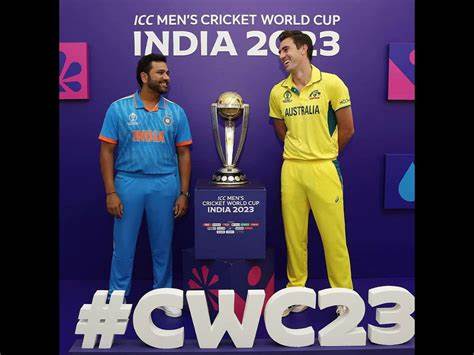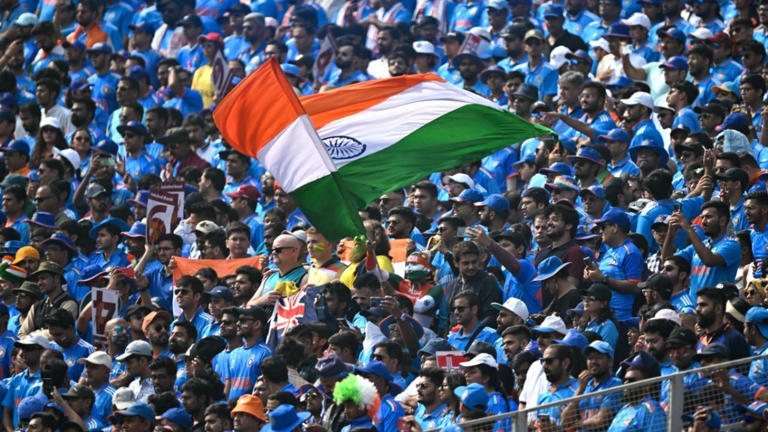Motera buried in a sea of blue : ICC World Cup 2023

Motera buried in a sea of blue
The Narendra Modi Stadium in Ahmedabad’s Motera became the epicenter of an electric atmosphere as cricket enthusiasts swarmed towards the venue in anticipation of the ICC World Cup 2023 final between India and Australia. The stadium, with a staggering capacity of 1.32 lakh, was adorned in a sea of blue as fans fervently hoped for an emphatic Indian victory and the subsequent lifting of the prestigious trophy.
The enthusiasm was palpable among the thousands of supporters who had donned the iconic blue jerseys of the Indian cricket team. As the crowd made its way to the stadium, there was a flurry of last-minute purchases from vendors lining the roads leading to the venue. The air was charged with excitement and optimism, creating an unforgettable pre-match buzz.
Beyond jerseys, the tricolor – representing the Indian flag – fluttered prominently, adding a patriotic touch to the vibrant scene. Traditional Indian headgear, including ‘pagdis’ in saffron, white, and green, further contributed to the display of national pride. Among the diverse range of merchandise, masks featuring the likenesses of cricket maestro ‘King’ Virat Kohli and Prime Minister Narendra Modi were particularly popular, emphasizing the fusion of cricket fervor and political enthusiasm.
The convergence of cricket and cultural elements showcased the deeply rooted connection between the sport and national identity. The atmosphere surrounding the stadium painted a vivid picture of collective anticipation and shared aspirations, reflecting the unifying power of cricket in India.

As the stage was set for the pinnacle clash, the ambiance in and around the Narendra Modi Stadium not only celebrated the spirit of the game but also underscored the significance of cricket as a cultural phenomenon that brings people together in a shared passion for victory and national pride.
The vibrant scene around the Narendra Modi Stadium wasn’t limited to jerseys and flags; fans were taking their enthusiasm to the next level by getting their faces painted in the three colors of the Indian flag. Children, seizing the opportunity, set up face-painting stations and charged Rs 50 each, contributing to the festive atmosphere surrounding the ICC World Cup 2023 final.
The entire area echoed with patriotic chants, as the crowd fervently shouted slogans like ‘Bharat Mata ki Jai’ (Victory to Mother India) and ‘India Jeetega’ (India will win), creating an atmosphere reminiscent of a national festival. This level of exuberance is a testament to the deep connection between cricket and national pride in India, with sporting events transforming into cultural celebrations.
Interestingly, the diverse crowd included not only ardent Indian fans but also a sprinkling of Australians and foreign nationals eager to experience the unique fervor of cricket in a nation known for its passion for the sport. The inclusivity of the event highlighted cricket’s universal appeal and its ability to bring people from different backgrounds together in a shared celebration.
Among the international supporters was Ben, who, despite being from New Zealand, proudly sported the Indian jersey, showcasing the global nature of cricket fandom. Ferdenand from South Africa went a step further, painting his face in the colors of the Indian flag (saffron, white, and green) to express his support for Rohit Sharma and the Indian team, which had maintained an unbeaten record throughout the tournament.
The presence of fans from various corners of the world, all united by their love for cricket and the spirit of sportsmanship, added an extra layer of diversity to the cricketing spectacle. It also underscored the global impact of cricket as a cultural phenomenon, transcending boundaries and bringing people together in celebration of the game.
The cricket fever at the Narendra Modi Stadium transcended national boundaries, drawing fans from various corners of the world. Ferdenand, a South African supporter, expressed his immense admiration for the Indian cricket team, emphasizing that, irrespective of the outcome, the final would be an epic battle between two strong teams. While acknowledging the strength of both sides, Ferdenand leaned towards India, expressing his belief in the team’s higher chances of victory.
Another fan, Vinay Agarwal, brought an international flair to the crowd by proudly displaying the flag of Nepal painted on his cheek. Agarwal revealed that he had traveled from the Himalayan nation to offer support to neighboring India, showcasing the camaraderie between cricket-loving nations and the way the sport brings diverse communities together.
The early-morning scenes around the stadium were characterized by the influx of fans from cities in Gujarat, including Surat, Rajkot, and Vadodara, as well as from Pune in Maharashtra. This mass migration of cricket enthusiasts underscored the immense popularity of the sport, turning the event into a regional celebration that went beyond the boundaries of the host city.
The diverse mix of supporters, both local and international, created a melting pot of cricket fervor, adding a unique and inclusive dimension to the World Cup final. The convergence of fans from different backgrounds, united by their shared passion for the sport, painted a vivid picture of the global appeal of cricket and its ability to foster connections and camaraderie across borders.
The passion for cricket, especially during a high-stakes event like the World Cup final, knows no bounds. Sukhbir Singh, a 70-year-old cricket enthusiast from Punjab, encapsulated this sentiment by stating that age is merely a number for him. Expressing his unwavering support for the Indian cricket team, especially his admiration for Virat Kohli, he affirmed that as long as he is physically capable, he will continue to attend matches. His confidence in India’s success in the World Cup reflected the unbridled optimism that cricket fans often bring to major tournaments.
The cricket fervor in Ahmedabad, serving as the epicenter of the cricketing world during the World Cup final, has also brought about a surge in hotel tariffs. The heightened demand for accommodation led to rates skyrocketing, with some rooms being offered at more than 10 times their normal price. In response to these exorbitant costs, some resourceful fans adopted a practical approach by opting to drive down to the city overnight, arriving just in time for the match. This strategic move allowed them to enjoy the cricketing spectacle without having to bear the burden of prohibitively expensive hotel stays.
Arun Sharma, part of a group of friends from Haryana who implemented this cost-saving measure, highlighted the financial considerations involved. By choosing to hire a taxi and making a day trip for the match, they found a more economical alternative to the steep hotel prices. This creative approach showcased the lengths to which fans are willing to go to be part of the cricketing experience, even when faced with logistical and financial challenges.
The diverse stories of cricket enthusiasts, spanning different ages and regions, contribute to the rich tapestry of the cricketing culture in India, where the sport holds a special place in the hearts of millions.
Bansilal Dantani, a resident of the city living an ascetic life, added a unique and memorable touch to the cricketing spectacle unfolding near the stadium. He became an instant sensation among fans as he arrived with a 10-foot tall cutout of Prime Minister Narendra Modi, creating a photo opportunity for those eager to capture the moment with the larger-than-life image.
Dantani’s connection to cricket dates back to 1994 when, during a match at the old Motera stadium, he jumped in to run towards Kapil Dev to express his congratulations after India emerged victorious. His singular wish is to meet Kapil Dev once again. Drawing a connection between the presence of both Narendra Modi and Kapil Dev at the match, Dantani expressed a belief that India would secure victory because luck was on their side.
This gesture by Bansilal Dantani not only showcased the enthusiasm and creativity of cricket fans but also highlighted the sentimental connections that people often associate with cricket. His presence and the symbolic cutout added a touch of joy and camaraderie to the overall atmosphere, emphasizing the inclusive and celebratory nature of major cricketing events.




